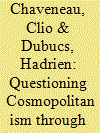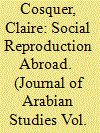| Srl | Item |
| 1 |
ID:
190345


|
|
|
|
|
| Summary/Abstract |
Owing to their diverse populations and particular social configurations, the United Arab Emirates offer a unique urban context in which to question the notion of cosmopolitanism and its daily manifestations, since the main cities of the Emirates maximize occasions for intercultural interaction while maintaining major economic divisions and social hierarchies in most parts of daily life. While national and ethnic categories in the Emirates are often presented in the literature as being rigid, this paper argues that a biographical approach allows for a finer analysis of cosmopolitan situations. The French residents of Abu Dhabi and Dubai, relatively privileged migrants, position themselves along a wide spectrum of places and activities, raising different social and urban issues. Based on 26 months of participant observation in Abu Dhabi and Dubai and 12 in-depth interviews with French residents of the UAE, this paper shows that their forms of sociability, social practices, and international mobility work together to shape diverse and sometimes paradoxical forms of openness to national, ethnic, or social “others”.
|
|
|
|
|
|
|
|
|
|
|
|
|
|
|
|
| 2 |
ID:
190347


|
|
|
|
|
| Summary/Abstract |
This article looks at how the highly internationalized context of Abu Dhabi and the benefits of migration intersect for French migrants. It analyzes the tensions surrounding a specific form of the repatriation of the benefits of migration: how these are passed on to children. While French migrants generally receive higher salaries and consolidate dominant class positions in Abu Dhabi, they also have to deal with the remoteness of national structures of social reproduction. Drawing on an ethnographic study of French migrants in Abu Dhabi conducted from October 2015 to May 2016 (participant observation and interviews, n = 70), this article argues that migrants adjust their educational strategies in order to build up a cosmopolitan repertoire and ensure different paths of social reproduction. The article introduces three forms of educational strategies and associated cosmopolitan repertoires and shows how these relate to the parents’ social positions.
|
|
|
|
|
|
|
|
|
|
|
|
|
|
|
|